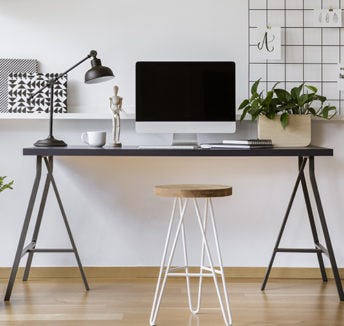
The struggle to balance jobs with family life will soon return for many. Could local flexspace help partners to share the load?
Long hours spent commuting. Expensive childcare. An almost non-existent work-life balance. It’s not easy to combine a career with family life – just ask any working parent.
In theory, then, the pivot to flexible working motivated by the Covid-19 pandemic should have been a boon for people with families. It’s certainly fair to say that both employees and employers have seen benefits, with everything from team members’ mental health to the carbon footprints of whole companies positively affected. For those with children, extra time spent reading stories, enjoying family meals and helping with homework has been precious.
Why go back?
Nevertheless, there are downsides to working from where you live, some of which have been felt acutely by people with families. During lockdowns, working parents have had to juggle increasing workloads with homeschooling and childcare, often with limited space and bandwidth – not to mention waning patience.
Research looking into the realities of working from home in spring 2021 reported that people were spending longer at their desks than they did before the pandemic hit. The average length of time an employee working from home in the UK, Austria, Canada or the USA was logged on at their computer increased by around two hours per day after the Covid-19 crisis began, with UK workers lengthening their working week by approximately 25%.
A poll conducted by Gallup in January 2021 showed that while 44% of employees in the USA wanted to continue working remotely, 39% were keen to head back to the office. For many people – perhaps parents in particular – the ability to draw a clear line between work time and downtime is appealing.
No doubt the promise of a distraction-free environment with business-grade WiFi and proper coffee also has its charms. After all, few people are at their most productive while trying to ignore household to-do lists, needy pets and the relentless whir of the washing machine.
A new world of work
As workplaces begin to reopen, it’s clear we’re entering a new era of increased flexibility. IWG – the world’s largest operator of office and flexspace, with brands including Spaces and Regus – has seen significant rises in demand as businesses embrace hybrid working for the long term.
This approach – which allows staff to mix home working, trips to the company HQ and time at local flexible workspaces – has led to increased interest in suburban and rural flexspace in 2021.
Many companies are choosing to adopt a hub-and-spoke way of working, embedding this permanently into their cultures. This model sees the company HQ as a centre (‘hub’) for collaborating and connecting, to which staff might travel only occasionally. The rest of the time, they have the freedom to work at locations (‘spokes’) closer to home.
The rise of hybrid working is great news for parents, with many hoping it signals the end of the Monday to Friday, 9-to-5 grind. As Mark Dixon, IWG founder and CEO says: “Herding people to the office is looking increasingly obsolete, expensive and inconvenient. Why should workers go to the effort and expense of dragging themselves into work to spend the day working on a device they have brought with them, and will return home with at the end of the day?”
Redressing the balance
Increased flexibility can throw up issues that families might not expect, though.
On average, women take responsibility for a disproportionate amount of childcare and unpaid domestic work – an issue that’s caused and perpetuated by the gender pay gap, and the tendency for men to have better paid careers that might require more commuting.
Partners who can continue working remotely after the pandemic may suddenly be in a position to pitch in more – and on a permanent basis. This opportunity to take on an equal share of ‘family jobs’ could help to combat the already severe effects of Covid-19 on women’s careers.
However, researchers have also warned of the ‘double-edged sword’ that flexibility can represent. A partner with a newly flexible job might find themselves expected to shoulder an even greater share of domestic tasks than before the pandemic if a fair division of the work can’t be determined.
Communication, then, is the key to deciding who goes back to the office and how often – and to ensuring that the plan is fair.
50/50 isn’t always fair
It’s worth pointing out that, for many families, a simple ‘half and half’ approach won’t make sense.
This isn’t only about who earns more – it’s also a question of whose job requires more face-to-face time with colleagues, and how long or expensive each partner’s commute is.
While it’s likely most individuals will need to spend some time at a company HQ, it may be that one partner’s need to travel is genuinely greater than the other’s. Such issues need to be addressed as couples come up with new, post-pandemic work schedules.
In addition, including use of a local coworking or flexible workspace in the discussion could help to mitigate partners’ worries about the pressures associated with home working.
Membership of a nearby Spaces, for instance, combines the convenience of staying close to home with the benefits of working in an office: reliable WiFi, good coffee and a creative, buzzy atmosphere (not punctuated by the pinging of the dishwasher). In terms of employee benefits, it’s likely that access to local flexible workspaces will be high on the wish lists of many workers, post-pandemic.
Global firms such as Standard Chartered bank and NTT have already recognised the value of embedding this within company culture. All have signed groundbreaking deals with IWG in 2021, with new partnerships providing over a million new people with access to its flexspaces worldwide.
If hybrid working is all about balance, perhaps it’s no surprise that – as with so many things in life – making it work for families requires honest conversations and compromise.
Enjoy this? You might also like these other Spaces magazine stories:
Share this article
 Read now Desk-scaping: how to curate your workspace for enhanced productivity
Read now Desk-scaping: how to curate your workspace for enhanced productivity
 Read now How the AI revolution is augmenting the new world of work
Read now How the AI revolution is augmenting the new world of work